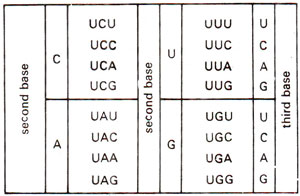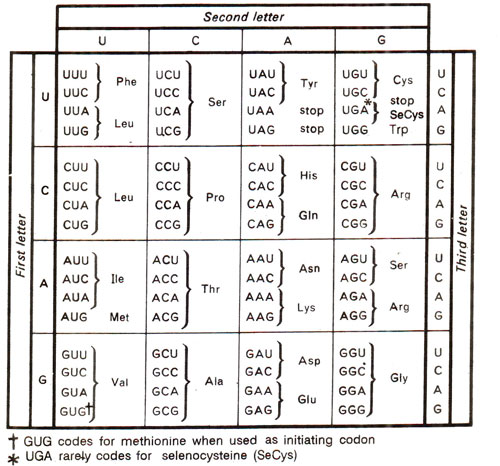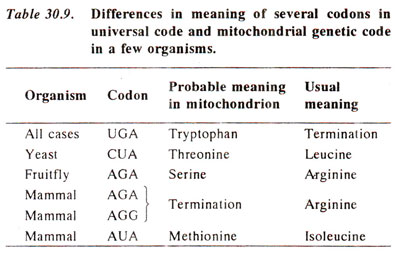New genetic codes in mitochondria and ciliate protozoa
Earlier we described that the genetic code is universal. It was also believed that the genetic code does not undergo any kind of evolution and, therefore, should be static. However, during 1980s, it was shown that variations in genetic code are found in mitochondria, particularly studied in yeast and mammals. In these cases (yeast mitochondria), UGA codes for tryptophan, although in the nuclear genes, UGA is a termination codon (Fig. 30.4). It has also been shown that although a new genetic code may exist in mitochondria, but mitochondria in all organisms may not have the same genetic code. For instance, UGA in mitochondria, does not always code for tryptophan. In the gene coding for maize cytochrome oxidase subunit II, UGA codon is not present and tryptophan is coded by codon CGG (coding for arginine in the nuclear genes; see Fig. 30.4), in addition to the codon UGG. There are also indications that AUA (coding for isoleucine in nuclear genes (see Fig. 30.4) codes for methionine in mitochondria of mammals, Xenopus, yeast, and Drosophila, but not in those of Neurospora and Aspergillus.
The CUN triplets (CUA, CUG, CUU, CUC) in yeast mitochondria, but not in some fungi, code for threonine instead of leucine. In mitochondria of mammals, but not in fungi, there are four initiating codons (AUG, AUA, AUU, AUC) instead of two (AUG, GUG) in the universal code, and they are recognized by N-formylmethionyl-tRNA as in bacteria, but unlike eukaryotes. Another unique feature of mitochondrial code of mammals and Xenopus, is the use of AGA and/or AGG as stop codons rather than as arginine codons. In mitochondria of Drosophila AGA appears to code for serine. It is thus obvious that there is considerable diversity in the genetic code of mitochondria (Table 30.8).

 The need for a different genetic code in mitochondria perhaps arose due to small genome size in mitochondria. This necessitated an evolutionary retrogression towards a more primitive code. In 1966, T.H. Jukes presented the concept of primitive code called archetypal code, in which one anticodon (in tRNA) will pair with a family of four codons due to wobbling at the first base of anticodon and third base of codon. This four way pairing will provide for only 15 amino acids instead of 20, since there are 16 anticodons (Fig. 30.7) and one of them will have to be excluded to provide for chain termination. However, in mammalian mitochondria (Mmt) this archetypal code is modified since provision needs to be made for 20 amino acids.
The need for a different genetic code in mitochondria perhaps arose due to small genome size in mitochondria. This necessitated an evolutionary retrogression towards a more primitive code. In 1966, T.H. Jukes presented the concept of primitive code called archetypal code, in which one anticodon (in tRNA) will pair with a family of four codons due to wobbling at the first base of anticodon and third base of codon. This four way pairing will provide for only 15 amino acids instead of 20, since there are 16 anticodons (Fig. 30.7) and one of them will have to be excluded to provide for chain termination. However, in mammalian mitochondria (Mmt) this archetypal code is modified since provision needs to be made for 20 amino acids.
Sequences of complete mitochondrial DNA are now known in human, bovine, mouse and some other organisms. Each mitochondrial DNA has been shown to have genes for 22 tRNAs as against 55 tRNAs in universal genetic code discovered in E. coli and applicable in most cases. These 22 tRNAs are sufficient to read codons for 20 amino acids and can pair with 60 codons,
remaining four codons being used for stop signals in Mmt. This reduction in the number of tRNAs is achieved by four way pairing and two way pairing. Four way pairing is used eight times (32 codons, 8 amino acids, 8 tRNAs); G pairs with U and C six times and U pairs with A and G another six times (24 codons; 12 amino acids; 12 tRNAs). This provides for 20 amino acids with 56 codons (using 20 tRNAs). Of the remaining eight codons, there arc two each for leucine and serine using two additional tRNAs, since both of them have six codons each and there are four stop codons (UAA, UAG, AGA, AGG). These 22 anticodons and their corresponding 20 amino acids are given in Figure 30.8.


The differences in universal code and mitochondrial code are given in Table 30.8, and the diversity in mitochondrial code in several organisms is shown in Table 30.9.
It will be interesting to compare Figure 30.8 with Figure 30.4. The major differences include : (i) one termination codon (UGA) and two arginine codons (AGA, AGG) in universal code; UGA in Mmt (mammalian mitochondria) coding for tryptophan and AGA and AGG in Mmt coding for stop signals; (ii) number of tRNAs is 22 in Mmt code, while it is 55 in E. coli. In Table 30.9 it is also apparent that the mitochondrial code in mammals and yeast may differ in some respects.
In 1986, a different genetic code (like in mitochondria) has been shown to be present in ciliate protozoa (Mycoplasma capricolum). In this genetic code, codons UAA and UAG specify glutamine instead of stop signals. In future, more such cases may come to light among primitive organisms.

Fig. 30.7. An archetypal code, showing 16 (sixteen) anticodons, with first base (5') always U (uracil) which can wobble and pair with any of the four bases at 3' end of mRNA triplet codon - (for details see text).

Fig. 30.8. Anticodons in the mammalian mitochondrial genetic code; anticodons in each box are meant for four mRNA triplet codons shown in Fig. 30.4. For instance, anticodon GAA pairs with codons UUU and UUC, anticodon UAA with codons UUA and UUG, anticodon UAG with CUU, CUC, CUA and CUG and so on.
Sequences of complete mitochondrial DNA are now known in human, bovine, mouse and some other organisms. Each mitochondrial DNA has been shown to have genes for 22 tRNAs as against 55 tRNAs in universal genetic code discovered in E. coli and applicable in most cases. These 22 tRNAs are sufficient to read codons for 20 amino acids and can pair with 60 codons,

Fig. 30.7. An archetypal code, showing 16 (sixteen) anticodons, with first base (5') always U (uracil) which can wobble and pair with any of the four bases at 3' end of mRNA triplet codon - (for details see text).

Fig. 30.8. Anticodons in the mammalian mitochondrial genetic code; anticodons in each box are meant for four mRNA triplet codons shown in Fig. 30.4. For instance, anticodon GAA pairs with codons UUU and UUC, anticodon UAA with codons UUA and UUG, anticodon UAG with CUU, CUC, CUA and CUG and so on.
The differences in universal code and mitochondrial code are given in Table 30.8, and the diversity in mitochondrial code in several organisms is shown in Table 30.9.







